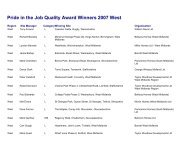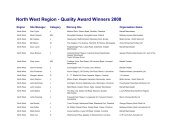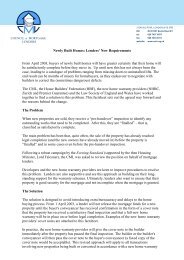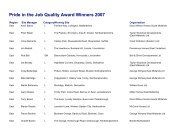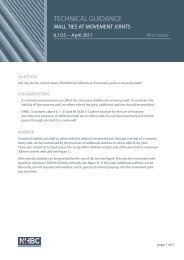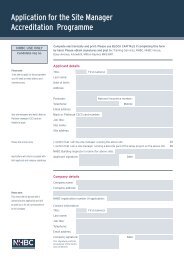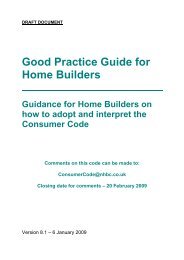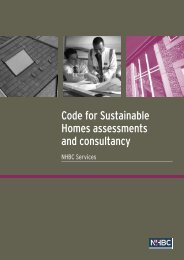Download Technical Extra 09 pdf - NHBC Home
Download Technical Extra 09 pdf - NHBC Home
Download Technical Extra 09 pdf - NHBC Home
You also want an ePaper? Increase the reach of your titles
YUMPU automatically turns print PDFs into web optimized ePapers that Google loves.
<strong>Technical</strong><br />
<strong>Extra</strong><br />
March 2013 | Issue <strong>09</strong><br />
In this issue:<br />
<strong>NHBC</strong> STANDARDS<br />
Annual claims feedback<br />
Roof tiling – good practice<br />
Corrosion protection of steel<br />
page 3<br />
page 6<br />
page 9<br />
REGULATION AND COMPLIANCE<br />
Latest changes to Building Regulations in England page 10<br />
GUIDANCE AND GOOD PRACTICE<br />
Biomass – safe storage of wood pellets page 12<br />
The use of recycled and secondary materials in<br />
residential construction<br />
page 13<br />
Mechanical ventilation with heat recovery (MVHR) page 16<br />
<strong>NHBC</strong> Foundation page 17<br />
INFORMATION AND SUPPORT<br />
Training courses, downloads, contact details and <strong>NHBC</strong><br />
technical events page 18
Foreword<br />
Welcome to the first <strong>Technical</strong> <strong>Extra</strong> of 2013.<br />
In this edition, we review <strong>NHBC</strong>’s claims experience and<br />
introduce the areas that will be the focus of <strong>NHBC</strong>’s<br />
standards-raising activity over the coming months.<br />
We also reflect on some disappointing results from our latest pitched roof survey of<br />
live sites, and highlight where small improvements to construction practice can make<br />
a significant impact in improving standards and reducing future costs.<br />
The 2013 edition of <strong>NHBC</strong> Standards came into effect for all homes where foundations<br />
were begun after 1 January 2013. If you require further copies of the Standards, please<br />
contact us at osupplies@nhbc.co.uk.<br />
I can also confirm that, for the first time, the Standards is available in a new digital<br />
catalogue which can be accessed online. This will give you:<br />
• easy-to-find content with a built-in word search<br />
• the option to extract sections of the Standards to paste, print or forward to others<br />
if required.<br />
<strong>NHBC</strong> registered builders can access this new version via the <strong>NHBC</strong> <strong>Extra</strong>net.<br />
The digital version of the Standards allows us to provide links to a range of<br />
supplementary resource provided by <strong>NHBC</strong> and other organisations, and we’ll be<br />
releasing updates to these links throughout the year. Linked information will include:<br />
• the regular technical updates we give to industry via <strong>Technical</strong> <strong>Extra</strong><br />
• supporting guidance such as that given in <strong>Technical</strong> Guidance<br />
• frequently asked questions, including those related to building control issues<br />
• training material, ranging from in-company training to the online courses available<br />
from <strong>NHBC</strong>’s Learning Hub.<br />
Whilst some of this supporting material will be new, the digital format allows us to help<br />
you find current, relevant information quickly.<br />
Recognising the importance of accessing information remotely on mobile and tablet<br />
size devices, <strong>NHBC</strong> is also committed to developing ‘apps’. <strong>NHBC</strong> is pleased to<br />
announce that the first technical app will be based on our foundation depth calculator.<br />
I hope to be able to provide further information on the development of our technical<br />
apps later in the year. Further information will become available on our website<br />
www.nhbc.co.uk, and updates will be sent out via Clicks & Mortar, the monthly<br />
e-newsletter from <strong>NHBC</strong>.<br />
Mark Jones<br />
Group Head of House-Building Standards
<strong>NHBC</strong> STANDARDS<br />
Annual claims feedback<br />
Who should read this: <strong>Technical</strong> and construction directors and<br />
managers, architects, designers and site managers.<br />
INTRODUCTION<br />
<strong>NHBC</strong>’s purpose is to ‘Raise standards to protect<br />
homeowners’. We recently celebrated our 75 th year<br />
protecting homeowners and supporting the housebuilding<br />
industry.<br />
By understanding and feeding back the issues that<br />
are affecting the house-building industry, we’re able<br />
to raise standards in new homes. Central to <strong>NHBC</strong>’s<br />
role, this work is co-ordinated by our House-Building<br />
Standards department.<br />
In this article, we provide some high-level feedback on<br />
the type of claims typically seen by <strong>NHBC</strong>. Building on<br />
the recent work to raise awareness of pitched roof<br />
claims, we’ll be sharing more detailed information,<br />
and highlighting where you can get further help<br />
and guidance.<br />
REQUIREMENTS<br />
Claims in years 3-10<br />
Back in <strong>Technical</strong> <strong>Extra</strong> 01 (February 2011), we<br />
highlighted that 60% of all claims related to pitched<br />
roofs. The 10 years of cover provided by <strong>NHBC</strong>’s<br />
Buildmark warranty means that, despite recent work<br />
through a co-ordinated campaign of activities to raise<br />
awareness of pitched roof issues, we’ll see historic<br />
claims coming through for some time to come.<br />
The chart below, showing the number of claims<br />
recorded against <strong>NHBC</strong> Standards per 1,000 plots<br />
under cover, indicates that the proportion of claims<br />
related to pitched roofs may have reached a plateau.<br />
Analysis has also highlighted that, for each generation<br />
(year) of build, pitched roof claims are typically<br />
peaking in the later years of cover, and that early<br />
performance of more recent generations appears to<br />
show signs of improvement.<br />
Claims per 1,000 plots<br />
10<br />
9<br />
8<br />
7<br />
6<br />
5<br />
4<br />
3<br />
2<br />
1<br />
0<br />
20<strong>09</strong> 2010 2011 2012<br />
Other<br />
Ancillary buildings and external works<br />
Services, fixtures and finishes<br />
Roofs<br />
Superstucture<br />
Substructure and ground floors<br />
Foundations<br />
For technical advice and support, call 01908 747384 or visit www.nhbc.co.uk<br />
<strong>Technical</strong> <strong>Extra</strong> | Issue <strong>09</strong> | March 2013 | Page 3
<strong>NHBC</strong> STANDARDS<br />
Annual claims feedback<br />
REQUIREMENTS (CONTINUED)<br />
Whilst improvements in early-year performance is<br />
encouraging, it’s vital that we don’t forget the lessons<br />
learnt, and that we adhere to the latest guidance<br />
given in the current version of Chapter 7.2, published<br />
in the 2013 edition of <strong>NHBC</strong> Standards. Indeed, we<br />
discuss disappointing results from a recent survey on<br />
pitched roofs later in this edition, and highlight areas<br />
where further improvements can be made.<br />
After pitched roofs, where mortar and<br />
weathertightness issues have dominated,<br />
superstructure claims consistently account for the<br />
next highest number; at circa 30% of year 3-10 claims<br />
in recent years. Claims affecting the external envelope<br />
dominate; and two areas in particular:<br />
■■<br />
■■<br />
Cavity tray/damp proof courses (DPC).<br />
Render.<br />
These areas account for almost half of all claims related<br />
to the external envelope by both number and cost.<br />
altogether. However, with render, de-bonding from the<br />
substrate is the most common cause recorded. Our<br />
investigations and guidance will focus on common<br />
causes for this and how it can be prevented.<br />
In addition to focused campaigns throughout 2013/14<br />
on cavity trays/DPCs and render, we’ll continue our<br />
work on pitched roofs and focus on three other areas:<br />
■■<br />
■■<br />
■■<br />
Basements.<br />
Foundations.<br />
Groundbearing floors.<br />
Claims in years 0-2<br />
In the first two years of <strong>NHBC</strong>’s Buildmark warranty<br />
we see claims relating to services, fixtures and<br />
finishes (Chapter 1.2 ‘A consistent approach to<br />
finishes’ and Part 8 ‘Services and internal finishes’)<br />
dominating.<br />
Chapter 8.1 ‘Internal services’ is also prominent, and<br />
our review of claims has highlighted that many of<br />
these are attributed to installation issues. We’ll look to<br />
provide further information on this type of claim later<br />
in the year.<br />
Claims raised in the first two years<br />
Ancillary buildings<br />
and external works 10%<br />
Substructure and<br />
ground floors 4%<br />
Services, fixtures<br />
and finishes<br />
42%<br />
Superstructure<br />
32%<br />
Throughout 2013/14, <strong>NHBC</strong> will be focusing on these<br />
areas to raise awareness of the issues we typically find.<br />
Initial investigations confirm that, for cavity tray and<br />
DPC issues, common causes are attributed to<br />
inadequate joins to trays, trays and/or DPCs being<br />
incorrectly positioned or trays found to be missing<br />
Roofs<br />
11%<br />
For technical advice and support, call 01908 747384 or visit www.nhbc.co.uk<br />
Page 4 | March 2013 | Issue <strong>09</strong> | <strong>Technical</strong> <strong>Extra</strong>
Annual claims feedback<br />
REQUIREMENTS (CONTINUED)<br />
Reports and further assistance<br />
This introduction to claims feedback has highlighted<br />
the main areas of claims seen by <strong>NHBC</strong>, the areas<br />
industry can focus on to reduce claims and some of<br />
the campaigns we’ll be using to help raise standards.<br />
Feeding back our findings is an important part of this<br />
process, and we’ll be developing improved reporting<br />
tools to highlight generic and specific industry and<br />
builder performance this year.<br />
For builders with a higher claims experience, resulting<br />
from a larger number of homes under cover, House-<br />
Building Standards reports will highlight common<br />
claims and suggest specific actions which, if<br />
addressed, could potentially reduce the number of<br />
claims, improving homeowner satisfaction and<br />
reducing costs.<br />
Where the volume of claims makes detailed analysis<br />
less meaningful, generic reporting on the type of<br />
issues typically affecting common areas of the build<br />
will help to highlight the issues and how these can<br />
be avoided.<br />
<strong>NHBC</strong> Standards<br />
For the first time, the Standards is available in a new<br />
digital catalogue which can be accessed online<br />
giving you:<br />
■■<br />
■■<br />
easy-to-find content with a built-in word search<br />
the option to extract sections of the Standards to<br />
paste, print or forward to others if required.<br />
<strong>NHBC</strong> registered builders can access this new version<br />
via the <strong>NHBC</strong> <strong>Extra</strong>net.<br />
The digital version of the Standards allows us to<br />
provide links to a range of supplementary resource<br />
provided by <strong>NHBC</strong> and other organisations, and we’ll<br />
be releasing updates to these links throughout the<br />
year. Linked information will include:<br />
■■<br />
■■<br />
■■<br />
■■<br />
the regular technical updates we give to industry<br />
via <strong>Technical</strong> <strong>Extra</strong><br />
supporting guidance such as that given in<br />
<strong>Technical</strong> Guidance<br />
frequently asked questions, including those<br />
related to building control issues<br />
training material, ranging from in-company<br />
training to the online courses available from<br />
<strong>NHBC</strong>’s Learning Hub.<br />
YOU NEED TO…<br />
■■<br />
■■<br />
■■<br />
■■<br />
Read the pitched roof article later in this edition and ensure that your sites are following the latest<br />
requirements of Chapter 7.2 – ‘Pitched roofs’.<br />
Look out for further information on the type of cavity tray/DPC claims <strong>NHBC</strong> investigates and the guidance<br />
on how to avoid these.<br />
Note the other upcoming campaigns and supporting information and guidance, including reports. Further<br />
information will follow in future editions of <strong>Technical</strong> <strong>Extra</strong>.<br />
Access <strong>NHBC</strong> Standards online via the <strong>Extra</strong>net for easy access to the latest supplementary resources.<br />
For technical advice and support, call 01908 747384 or visit www.nhbc.co.uk<br />
<strong>Technical</strong> <strong>Extra</strong> | Issue <strong>09</strong> | March 2013 | Page 5
<strong>NHBC</strong> STANDARDS<br />
Roof tiling – good practice<br />
Who should read this: <strong>Technical</strong> and construction directors and managers,<br />
architects, designers and site managers, roofing subcontractors and tile manufacturers.<br />
INTRODUCTION<br />
<strong>NHBC</strong> Standards Chapter 7.2 ‘Pitched roofs’ covers<br />
the design and installation of roof coverings<br />
together with guidance on how various details<br />
should be implemented on site.<br />
STANDARDS CHAPTER<br />
Chapter 7.2 ‘Pitched roofs’.<br />
Specific guidance has been developed in response<br />
to high levels of claims due to inadequate<br />
installation and design. When following the <strong>NHBC</strong><br />
guidance, it is also important that the roof tile<br />
manufacturer’s installation guidance be consulted<br />
and adopted as appropriate.<br />
REQUIREMENTS<br />
Disappointing feedback from recent survey<br />
Changes to <strong>NHBC</strong> Standards were introduced at the<br />
start of 2012 following the high number of pitched<br />
roof claims <strong>NHBC</strong> had seen in recent years and, in<br />
particular, the performance of mortar.<br />
A survey of around 3,000 ongoing sites was recently<br />
completed in order to help <strong>NHBC</strong> understand how well<br />
the industry has moved to adopt the new<br />
requirements. Unfortunately, some of the findings<br />
were disappointing, and highlight the importance of<br />
continued focus and attention on what, in many cases,<br />
are basic faults that can and should be avoided by<br />
good design and construction practice.<br />
Issues highlighted by the survey include:<br />
Mechanical fixing<br />
Where ridges and hips are bedded on mortar, a<br />
third are still using mortar only. Chapter 7.2 states<br />
these areas must also be mechanically fixed.<br />
Action: Ensure that all ridges and hips<br />
that are bedded on mortar are also<br />
mechanically fixed.<br />
Mortar to verges<br />
Where verges are bedded on mortar, less than<br />
half of the sites surveyed are using the correct<br />
method (either bedding and pointing immediately<br />
or bedded and pointed following initial ‘stiffening’<br />
of the mix). Verge failure due to incorrect mortar<br />
placement is a common defect and expensive<br />
to repair.<br />
Action: At verges, ensure tiles are bedded in<br />
one operation on roofing mortar having a<br />
minimum width of 100mm.<br />
For technical advice and support, call 01908 747384 or visit www.nhbc.co.uk<br />
Page 6 | March 2013 | Issue <strong>09</strong> | <strong>Technical</strong> <strong>Extra</strong>
Roof tiling – good practice<br />
REQUIREMENTS (CONTINUED)<br />
Correct mortar mix<br />
The correct mortar mix could only be positively<br />
confirmed on two-thirds of the sites surveyed.<br />
Action: Roofing mortar should be 1:3<br />
cement:sand with plasticiser. The mix should<br />
be based on sharp sand with soft sand added<br />
to achieve workability. The proportion of<br />
sharp sand should not be less than one-third<br />
of the total sand content.<br />
The survey did highlight that an increasing proportion<br />
of sites are moving to dry systems, reducing or<br />
removing some of the risks highlighted previously.<br />
However, a large number of sites still retain some<br />
element of mortar work to roofs.<br />
Almost all sites surveyed in Scotland were using dry<br />
systems, and their use has increased by around 20%<br />
in England and Wales since the previous survey,<br />
undertaken in 2011. When using dry systems, it is vital<br />
to ensure that the correct system is specified for the<br />
pitch of the roof and that the tile and dry system<br />
components are compatible.<br />
Fixing schedules<br />
Fixing schedules should be used and available for<br />
inspection. Whilst this is an area that appears to<br />
have improved, almost a quarter of all sites<br />
surveyed did not have a fixing schedule available.<br />
Action: Ensure a fixing schedule, including<br />
details to ridges and hips etc., is used and<br />
available on site for review.<br />
Small cut tiles<br />
Half of the sites surveyed were using small cut<br />
single lapped interlocking concrete tiles less than<br />
a half tile width, with a third fixing them with an<br />
adhesive not supplied by the tile manufacturer.<br />
Action: Where possible, try to use setting out<br />
to avoid cut tiles. Where cut tiles are<br />
unavoidable, ensure they are at least a half<br />
tile width and use manufacturer’s approved<br />
methods of securing the cut tile using either<br />
adhesives and/or a minimum of three<br />
mechanical fixings.<br />
Valleys<br />
Some valley tiles are being cut in situ, on the<br />
finished valley line. This potentially can damage<br />
the valley, and the tile dust will affect<br />
mortar adhesion.<br />
Action: When cutting valley tiles, either do so<br />
off roof or set out and cut valley tiles two<br />
tiles back from the valley line in situ.<br />
Working directly with the roofing industry<br />
As part of our continuing work to improve the quality<br />
of pitched roofs, <strong>NHBC</strong> recently met with the major<br />
roof tile manufacturers, together with members of the<br />
National Federation of Roofing Contractors (NFRC)<br />
and the recently formed Roofing Tile Alliance (RTA).<br />
The RTA is a working alliance of the members of the<br />
Concrete Tile Manufacturers Association (CTMA) and<br />
the Clay Roof Tile Council (CRTC). The aim of the RTA<br />
going forward is to promote the common interests of<br />
all roof tile manufacturers and work towards providing<br />
unified specifications to address roofing issues.<br />
The meeting covered specification and site practice<br />
issues related to bedded and dry verges, including the<br />
fixing of cut tiles and use of verge clips. Proprietary<br />
dry verge systems were reviewed, with specific<br />
consideration given to their performance and<br />
specification. The <strong>NHBC</strong>’s requirements for<br />
mechanical fixing of mortared ridge and hip tiles were<br />
considered in relation to individual tile manufacturer’s<br />
solutions. Other items discussed included the use of<br />
coloured mortars, detailing at abutments on splayed<br />
bays and at chimneys, wet cutting of tiles, and fixing<br />
of cut tiles in valleys and on hips, together with<br />
certain regional roofing practices.<br />
For technical advice and support, call 01908 747384 or visit www.nhbc.co.uk<br />
<strong>Technical</strong> <strong>Extra</strong> | Issue <strong>09</strong> | March 2013 | Page 7
<strong>NHBC</strong> STANDARDS<br />
Roof tiling – good practice<br />
REQUIREMENTS (CONTINUED)<br />
Action points were identified for all parties, and a<br />
further meeting of the group is planned to review the<br />
feedback and action taken since the first meeting, and<br />
consider further intervention following the recent<br />
survey results.<br />
Revised inspection protocol<br />
In <strong>Technical</strong> <strong>Extra</strong> 01, we highlighted the need for our<br />
inspectors to be called out to site to discuss with<br />
builder site management teams their specific roofing<br />
proposals, and inspect the first available roof where a<br />
wet system of bedding was proposed.<br />
To further aid our builder customers, we continue to<br />
offer free ‘pitched roof covering’ training upon<br />
request, and have a number of free and paid-for courses<br />
available on our website and via supplementary<br />
resources in the digital version of the Standards.<br />
<strong>NHBC</strong> Standards 2013 edition<br />
With regard to the recent publication of Standards<br />
2013, we have become aware of a printing error in<br />
Chapter 7.2 ‘Pitched roofs’. In Clauses M5(k), S11(e)<br />
and table 1 of Appendix 7.2-A, where the text should<br />
read one-third a square symbol appears in error.<br />
Please accept our apologies for this error and<br />
ensure that a value of ⅓ is used where the square<br />
symbol appears.<br />
YOU NEED TO…<br />
■■<br />
■■<br />
■■<br />
■■<br />
■■<br />
■■<br />
Ensure that all ridges and hips that are bedded on mortar are also mechanically fixed.<br />
At verges, ensure tiles are bedded on roofing mortar having a minimum width of 100mm and that these<br />
are bedded and pointed in one operation.<br />
Ensure roofing mortar is 1:3 cement:sand with plasticiser. The mix should be based on sharp sand with<br />
soft sand added to achieve workability. The proportion of sharp sand should not be less than one-third<br />
of the total sand content.<br />
Ensure a fixing schedule, including details to ridges and hips etc., is used and available on site<br />
for review.<br />
Where cut tiles are unavoidable, ensure they are at least half tile width and use manufacturer’s<br />
approved methods of securing the cut tile using either adhesives and/or a minimum of three<br />
mechanical fixings.<br />
Note the further guidance on how to meet <strong>NHBC</strong> requirements in other editions of <strong>Technical</strong> <strong>Extra</strong> and<br />
also on the NFRC and individual roof tile manufacturer’s websites.<br />
■■<br />
Make the amendment detailed above to <strong>NHBC</strong> Standards 2013.<br />
For technical advice and support, call 01908 747384 or visit www.nhbc.co.uk<br />
Page 8 | March 2013 | Issue <strong>09</strong> | <strong>Technical</strong> <strong>Extra</strong>
Corrosion protection of steel<br />
Who should read this: <strong>Technical</strong> and construction directors and<br />
managers, architects, designers and site managers.<br />
INTRODUCTION<br />
<strong>NHBC</strong> is aware of a number of high-cost claims<br />
resulting from corrosion to external balcony<br />
steelwork, particularly in coastal locations. The<br />
main cause appears to be inadequate protection<br />
of steelwork. <strong>NHBC</strong> has reviewed the guidance for<br />
protection of steel and will be updating future<br />
editions of the Standards, as outlined below, to<br />
provide guidance for protection of steelwork in<br />
coastal locations.<br />
STANDARDS CHAPTER<br />
Chapters 6.5 ‘Steelwork’ and 8.5 ‘Painting<br />
and decorating’.<br />
REQUIREMENTS<br />
<strong>NHBC</strong> Standards gives guidance for the protection of<br />
steel in Chapters 6.5 ‘Steelwork’ and 8.5 ‘Painting and<br />
decorating’. Chapter 8.5 gives guidance for protection<br />
of external steel by referring to BS EN ISO 12944<br />
‘Paints and varnishes’ and BS EN ISO 14713 ‘Protection<br />
against corrosion of iron and steel in structures’. The<br />
requirements of galvanised treatment that is given in<br />
Clause 8.5 – D2(c) is appropriate for external balcony<br />
steelwork in sheltered in land locations, but a higher<br />
level of protection is required in coastal locations.<br />
BS EN ISO 12944-2 classifies atmospheric<br />
environments into ‘atmospheric corrosivity<br />
categories’: C1 to C4 represent very low, low, medium<br />
and high ‘atmospheric-corrosivity’ respectively, and<br />
C5-I very high (industrial), C5-M very high (marine)<br />
‘atmospheric corrosivity’. BS EN ISO 14713-1:20<strong>09</strong><br />
gives the corrosion rate for zinc galvanising, r corr,<br />
based on one year’s exposure to the corrosivity category.<br />
For external steelwork in sheltered locations more<br />
than 500m from the coast, category C3 is<br />
recommended, and a galvanising rate of 460 g/m 2<br />
should be applied. However, this may not provide<br />
suitable durability for locations within 500m of the<br />
coast where, in accordance with BS EN ISO 12944-2,<br />
category C5 will apply.<br />
Where external steel is located in an environment<br />
categorised as C4 or C5, a zinc coating of 710 g/m 2<br />
should be specified. Decorative finishes may be<br />
applied to galvanised steel following suitable<br />
preparation with a mordant wash.<br />
YOU NEED TO…<br />
Ensure that external steel on sites with an atmospheric corrosivity of C4 or C5 to BS EN ISO 12944, including<br />
sites within 500m from a coastal shoreline, is galvanised to a rate of 710 g/m 2 .<br />
For technical advice and support, call 01908 747384 or visit www.nhbc.co.uk<br />
<strong>Technical</strong> <strong>Extra</strong> | Issue <strong>09</strong> | March 2013 | Page 9
REGULATION AND COMPLIANCE<br />
Latest changes to Building Regulations in England<br />
Who should read this: <strong>Technical</strong> and construction directors and<br />
managers, architects and designers.<br />
INTRODUCTION<br />
Following the consultation carried out in 2012, the<br />
Department for Communities and Local<br />
Government has announced changes to the<br />
Building Regulations in England. The changes are<br />
aimed at reducing the burden on house builders<br />
and the rest of the construction industry.<br />
CHANGES TO REGULATIONS<br />
Building Regulations in England.<br />
The changes only affect England and accepted<br />
energy buildings in Wales. The Building Regulations<br />
for new houses built in Wales are unchanged.<br />
REQUIREMENTS<br />
With immediate effect<br />
Provisions within Local Acts in England (which placed<br />
additional provisions on certain buildings over and<br />
above the minimum requirements of the Building<br />
Regulations) for warehouses (over 7,000m 3 ), car parks<br />
and tall buildings (over 30m), were repealed on<br />
9 January 2013. The provisions relating to fire and<br />
rescue service access have been retained.<br />
If you have a project which is currently being<br />
designed or under construction and has been<br />
subject to any of the provisions being repealed,<br />
you may wish to consult with your design team<br />
to examine any implications that this new<br />
legislation may have. Any design changes<br />
brought about as part of this process should be<br />
submitted to <strong>NHBC</strong> Building Control in line with<br />
your normal processes.<br />
Changes from 6 April 2013<br />
To reduce the burden on the construction industry,<br />
the Government has introduced further changes to<br />
the building control system:<br />
Removal of the Warranty Link Rule<br />
Since 2005, new homes built for sale or rent have had<br />
to have a designated warranty in place when using an<br />
Approved Inspector for building control. This was not<br />
the case if the local authority was providing building<br />
control. From April 2013, the Warranty Link Rule will<br />
be removed, freeing up any restrictions on the choice<br />
of building control body.<br />
This change will affect all plots on Initial Notices<br />
submitted on or after 6 April 2013. Plots on<br />
Initial Notices submitted before 6 April 2013 will<br />
still be subject to the Warranty Link Rule.<br />
For new buildings which will be occupied by public<br />
authorities, a new analysis must be provided to show<br />
that designers have considered the use of high-efficiency<br />
systems to provide heating and power for those<br />
buildings. Building control bodies will not be able to<br />
issue Final Certificates if this has not been received.<br />
This comes into force for all buildings on 9 July 2013.<br />
Changes to Completion and Final Certificates<br />
Public sector building control will be required to issue<br />
Completion Certificates where they are satisfied that<br />
work complies with the Building Regulations. This<br />
aligns the public sector requirement with that for<br />
Approved Inspectors. In addition, the wording on both<br />
Completion Certificates and Final Certificates is to be<br />
amended to clarify that the certificate is evidence, but<br />
For Building Regulations advice and support, call 0844 633 1000 and ask for ‘Building Control’ or visit www.nhbc.co.uk/bc<br />
Page 10 | March 2013 | Issue <strong>09</strong> | <strong>Technical</strong> <strong>Extra</strong>
Latest changes to Building Regulations in England<br />
REQUIREMENTS (CONTINUED)<br />
not conclusive evidence, that the requirements of the<br />
Building Regulations have been complied with. This<br />
reinforces the fact that the responsibility for<br />
compliance with the Building Regulations rests with<br />
the person carrying out the work.<br />
New Approved Documents<br />
Alongside the regulatory changes, three new<br />
Approved Documents will be published, as well as<br />
amendments to other existing documents. The<br />
biggest change is the publication of a new Approved<br />
Document K which brings together guidance from<br />
Part B, Part K, Part M and Part N of the previous<br />
regulations in respect of stairs, ramps, barriers etc.<br />
The new Part P contains guidance on a narrower<br />
definition of notifiable work and also suggests a<br />
method by which a competent DIYer can carry out<br />
work and have it tested by a competent third party.<br />
Removal of statutory notifications<br />
The system of statutory notifications when using a<br />
local authority for building control is being removed.<br />
From 6 April 2013, all building control bodies will be<br />
required to provide a service plan to their customers,<br />
risk assessing inspection regimes according to the<br />
building type and informing the customer when they<br />
wish to inspect. <strong>NHBC</strong> Building Control customers will<br />
already be familiar with this process, which has been<br />
used effectively on all <strong>NHBC</strong> sites.<br />
Changes from 9 July 2013<br />
The Government has clarified the conditions around<br />
the renovation of thermal elements, and the specific<br />
thresholds over which action will be required if<br />
carrying out repairs or maintenance on existing<br />
buildings. If more than 50% of a particular element,<br />
or 25% of the building envelope, is affected by the<br />
repairs, the whole of that element or envelope must<br />
be upgraded to meet the thermal requirements set<br />
out in the regulations applicable at the time.<br />
More information on all of the changes, transitional<br />
provisions and the effect on <strong>NHBC</strong> Building Control<br />
customers can be found on <strong>NHBC</strong> TechZone at<br />
www.nhbc.co.uk/techzone.<br />
YOU NEED TO…<br />
■■<br />
■■<br />
Ensure you are aware of all changes, implementation dates and transitional provisions. (Some of the<br />
above changes to Building Regulations in England come into effect immediately).<br />
Discuss the effect of these changes on schemes registered with <strong>NHBC</strong>, by contacting your<br />
building control surveyor.<br />
For Building Regulations advice and support, call 0844 633 1000 and ask for ‘Building Control’ or visit www.nhbc.co.uk/bc<br />
<strong>Technical</strong> <strong>Extra</strong> | Issue <strong>09</strong> | March 2013 | Page 11
GUIDANCE AND GOOD PRACTICE<br />
Biomass – safe storage of wood pellets<br />
Who should read this: <strong>Technical</strong> and construction directors and<br />
managers, architects, designers and site managers.<br />
INTRODUCTION<br />
Biomass boilers fuelled by wood pellets can be used to provide heating and hot water in new homes. A recent<br />
safety notice from the Health and Safety Executive has highlighted potential dangers associated with the release<br />
of noxious gases, primarily carbon monoxide, from stored wood pellets.<br />
GUIDANCE<br />
The use of wood pellet biomass as a domestic fuel<br />
source has become more popular as a way of reducing<br />
carbon dioxide emissions when compared with the<br />
fuels traditionally used to provide space and water<br />
heating. Biomass boilers range from small appliances<br />
serving a single dwelling, perhaps housed in or<br />
adjacent to the dwelling, to large communal systems<br />
serving multiple dwellings, often housed in a large<br />
purpose-built plant room remote from the dwellings<br />
they serve.<br />
Biomass boilers will typically use a significant quantity<br />
of fuel; even small boilers can use several tonnes of<br />
pellets per year. Wood pellets, the most common type<br />
of biomass fuel, are formed from compressed wood<br />
chips and sawdust. The pellets are commonly stored<br />
in the plant room either in a hopper or adjacent to the<br />
boiler. As the wood pellets naturally degrade, carbon<br />
monoxide gas is released. Carbon monoxide is<br />
colourless, tasteless and odourless and, if present<br />
in significant concentration, has the potential to<br />
be harmful.<br />
<strong>NHBC</strong> has become aware of a few incidents relating to<br />
concentrations of carbon monoxide from large<br />
quantities of stored wood pellets. The Health and<br />
Safety Executive has released a safety notice entitled<br />
‘Risk of carbon monoxide release during the storage<br />
of wood pellets’. The safety notice draws attention to<br />
the dangers of storing wood pellets and offers safety<br />
advice to those who use, install, maintain or distribute<br />
wood pellet boilers and/or manufacture, store or<br />
distribute wood pellets.<br />
Although the main focus of concern is on wood pellets<br />
stored in large quantities, it is possible that the<br />
concentration of carbon monoxide could reach<br />
dangerous levels when pellets are stored in quantities<br />
typically used in domestic situations.<br />
<strong>NHBC</strong> has begun engagement with relevant parties to<br />
gain a more complete understanding of the issues and<br />
will publish further guidance when the picture<br />
becomes clearer.<br />
YOU NEED TO…<br />
■■<br />
■■<br />
You should take note of the HSE Safety Notice ‘Risk of carbon monoxide release during the storage of<br />
wood pellets’ available on the HSE website www.hse.gov.uk/safetybulletins/co-wood-pellets.htm, if you<br />
are planning to install a biomass boiler that uses wood pellets.<br />
Contact the manufacturer/supplier of your boiler or wood pellets/fuel if you have any further questions.<br />
For technical advice and support, call 01908 747384 or visit www.nhbc.co.uk<br />
Page 12 | March 2013 | Issue <strong>09</strong> | <strong>Technical</strong> <strong>Extra</strong>
The use of recycled and secondary materials in<br />
residential construction<br />
Who should read this: <strong>Technical</strong> and construction directors and<br />
managers, designers and site managers.<br />
INTRODUCTION<br />
Recycled and secondary materials are increasingly being used in<br />
residential construction, most commonly as hardcore (engineered<br />
infill material that is placed within the confines of building<br />
foundations to support a ground bearing floor slab). It is<br />
important that hardcore materials are selected carefully. They<br />
must be inherently appropriate for such a use and suitable for<br />
the particular site; for instance, they must not react with<br />
sulphates or acid ground conditions, if these are present. A BRE<br />
document, ‘Hardcore for supporting ground floors of buildings’<br />
(DG 522 Parts 1 and 2), includes advice on how to select<br />
appropriate hardcore material. Further guidance can be found in<br />
the <strong>NHBC</strong> Foundation publication NF45 ‘The use of recycled &<br />
secondary materials in residential construction’.<br />
Although recycled material such as crushed concrete, brickwork<br />
and blockwork, and secondary material such as steel slag,<br />
crushed glass and china clay, can be just as competent as primary<br />
aggregate such as sand, gravel and crushed stone, they can<br />
technically be regarded as waste, as defined by the Waste<br />
Framework Directive 2008. Nevertheless, it is possible to reuse<br />
them in a legal way; this guidance note discusses how regulatory<br />
compliance can be achieved.<br />
Image copyright BRE (UK),<br />
reproduced with permission<br />
Note that recycled materials are defined as those produced by<br />
processing selected inorganic material previously used in<br />
construction. Secondary materials are generally by-products of<br />
mining, quarrying or industrial processes.<br />
GUIDANCE<br />
England and Wales<br />
The appropriate waste regulatory solution for a<br />
source of recycled material depends on whether it is<br />
to be used on the site of origin or on other sites. Most<br />
secondary materials will always be waste; however,<br />
some, such as PFA, can be subject to a waste protocol<br />
which would render them a recovered product. For<br />
England and Wales, this is summarised below and in<br />
Figure 1 (on page 14).<br />
Use on the site of origin<br />
All brownfield sites where soils are being excavated<br />
and reused should, ideally, operate under the<br />
voluntary Definition of Waste: Development Industry<br />
Code of Practice (CoP), which requires a materials<br />
management plan (MMP) to be developed. The MMP<br />
describes the materials that are to be reused and<br />
demonstrates that they comply with four tests:<br />
a) They are suitable for use.<br />
b) There is certainty of their use.<br />
c) The right quantities are available.<br />
d) There will be no harm to health, safety or<br />
the environment.<br />
For technical advice and support, call 01908 747384 or visit www.nhbc.co.uk<br />
<strong>Technical</strong> <strong>Extra</strong> | Issue <strong>09</strong> | March 2013 | Page 13
GUIDANCE AND GOOD PRACTICE<br />
The use of recycled and secondary materials in<br />
residential construction<br />
GUIDANCE (CONTINUED)<br />
Recycled materials<br />
surplus<br />
Are you using<br />
it on the site<br />
origin?<br />
No<br />
Is it less<br />
than 5000<br />
tonnes?<br />
No<br />
APPLY WRAP<br />
PROTOCOL<br />
Yes<br />
Yes<br />
Figure 1: Options for achieving<br />
waste regulatory compliance in<br />
England and Wales (for details on<br />
how the situation in Scotland and<br />
Northern Ireland differs, see<br />
main article).<br />
EXTEND<br />
BROWNFIELD MMP<br />
APPLY U1<br />
EXEMPTION<br />
The Environment Agency’s stated position is that,<br />
where materials have been reused in accordance with<br />
the CoP and a declaration to this effect has been<br />
submitted to them by a qualified person, the materials<br />
will not be considered to be waste. (Full details of this<br />
scheme and the requirements for the qualified person<br />
declaration are given in the CoP, which is available for<br />
download from the CL:AIRE (Contaminated Land:<br />
Applications in Real Environments) website,<br />
www.claire.co.uk.)<br />
The most straightforward mechanism for reusing<br />
surplus recycled materials on the site of origin is to<br />
extend the MMP.<br />
(It should be noted that, in certain circumstances,<br />
there might not be any soil movement required in<br />
redevelopment of<br />
brownfield sites and, hence,<br />
an MMP will not have been<br />
produced. In these<br />
circumstances, an MMP can<br />
be developed for reuse of<br />
the secondary material.)<br />
Use on other sites<br />
Recycled materials can<br />
also be exported for use<br />
as general fill on other<br />
sites. In this case, the<br />
appropriate course of<br />
action depends on<br />
whether the weight of the<br />
surplus is less than or greater than 5,000t.<br />
Less than 5,000t<br />
Up to 5,000t of recycled materials for general fill can<br />
be used at each receiving site under a U1 exemption,<br />
which can be obtained by completing an online form<br />
on the Environment Agency website,<br />
www.environment-agency.gov.uk. There is no charge<br />
for this application, which must be completed in<br />
advance of any importation. The Environment Agency<br />
has five working days in which to acknowledge and<br />
register the exemption.<br />
Note that, when recycled materials are transferred<br />
between sites for reuse under a U1 exemption, they are<br />
considered to be waste. All such transfers must be<br />
made by a registered waste carrier with the relevant<br />
duty-of-care documentation. In this scenario, it will<br />
still be necessary to demonstrate the materials are<br />
suitable for the intended use.<br />
More than 5,000t<br />
If more than 5,000t is to be exported, the WRAP<br />
protocol gives an alternative mechanism for regulatory<br />
compliance. This provides a uniform control process<br />
for recycling demolition materials. When it is followed,<br />
the resultant aggregate is considered to be fully<br />
recovered and no longer waste. It also provides the<br />
user of the material with a quality-managed product<br />
to common standards, which increases confidence in<br />
its performance.<br />
The framework created by the protocol also provides<br />
a clear audit trail for those responsible for ensuring<br />
compliance with waste management legislation.<br />
For technical advice and support, call 01908 747384 or visit www.nhbc.co.uk<br />
Page 14 | March 2013 | Issue <strong>09</strong> | <strong>Technical</strong> <strong>Extra</strong>
The use of recycled and secondary materials in<br />
residential construction<br />
GUIDANCE (CONTINUED)<br />
Other options<br />
For completeness, it should also be noted that, in theory,<br />
there is another option: applying to the Environment<br />
Agency for a waste permit. This is a process that can<br />
take several months. Moreover, it should also be noted<br />
that, if <strong>NHBC</strong> is aware of a waste permit being in force<br />
on a site, a red condition will be applied to any<br />
affected plots and, consequently, it will be impossible<br />
to ‘final’ a property until the permit is discharged. As<br />
the process of discharging even a relatively<br />
straightforward permit can take considerable time, it<br />
is unlikely that this approach will prove viable for<br />
most housing developments.<br />
Scotland and Northern Ireland<br />
The situation in Scotland and Northern Ireland is<br />
slightly different from that in England and Wales<br />
because the Scottish Environment Protection Agency<br />
(SEPA) and the Northern Ireland Environment Agency<br />
(NIEA) do not endorse the CL:AIRE CoP. However,<br />
SEPA has its own position statement, ‘The land<br />
remediation and waste management guidelines’, but<br />
this document expressly deals with excavated soils and<br />
therefore does not necessarily deal with recycled<br />
aggregate. Similarly the NIEA has produced its own<br />
guidance on reuse of soils, ’Guidance on the<br />
Regulation of Greenfield Soil in Construction and<br />
Development’ but, again, this does not include<br />
recycled aggregate.<br />
As a consequence, even when reusing recycled aggregate<br />
on the site of origin in Scotland and Northern Ireland,<br />
it will be necessary either to register an exemption<br />
with SEPA/NIEA or follow the WRAP protocol.<br />
In both jurisdictions, exemptions are less restrictive<br />
than in England and Wales and, under both sets of<br />
regulations, paragraph 19 exemptions are likely to be the<br />
most appropriate. In Scotland, under paragraph 19, it<br />
is possible to use up to 50,000t of material, which is<br />
likely to be sufficient for most brownfield development<br />
projects, but in Northern Ireland, there can be<br />
restrictions in using over 20,000t. However, there are<br />
many rules concerning the use of the exemptions,<br />
together with requirements for inspections. There are<br />
also charges for registration of exemptions (£167 to<br />
£811 in Scotland and £585 in Northern Ireland). In view<br />
of this complexity, in order to ensure compliance with<br />
the regulations, a developer should contact SEPA or<br />
NIEA for advice.<br />
As in England and Wales, use of the WRAP protocol is<br />
an alternative approach.<br />
The correct regulatory solution depends on which<br />
part of the UK you are operating in and where the<br />
recycled materials are to be used:<br />
England and Wales<br />
On the site of origin,<br />
use the CL:AIRE CoP process.<br />
On other sites where there is less than 5,000t,<br />
a U1 exemption is required at the receiving site.<br />
Visit: www.environment-agency.gov.uk/business/<br />
topics/permitting/121138.aspx#online_registration<br />
On other sites where there is more than 5,000t,<br />
the producing site needs to follow the WRAP protocol.<br />
Scotland and Northern Ireland<br />
On any site,<br />
a paragraph 19 exemption is required. For further<br />
guidance on the use of paragraph 19 exemptions,<br />
restrictions and charges, visit:<br />
Scotland<br />
www.sepa.org.uk/waste/waste_regulation/<br />
application_forms/exempt_activities/<br />
paragraph_19.aspx<br />
Northern Ireland<br />
www.doeni.gov.uk/niea/waste-home/authorisation/<br />
exemption/wml_complex_exemptions/<br />
paragraph_19_exemption.htm<br />
YOU NEED TO…<br />
■■<br />
■■<br />
Because the processes for ensuring that materials are appropriately regulated are quite complex, developers<br />
must ensure that they have advisors who are adequately informed on waste regulatory issues.<br />
Before reusing recycled materials on site or transferring them for use on another site, you first need to ensure<br />
that they are fit for purpose. The BRE document, ‘Hardcore for supporting ground floors of buildings’,<br />
provides advice on how to select hardcore material that has the requisite physiochemical properties. You<br />
should also refer to <strong>NHBC</strong> Standards Chapter 4.1 to ensure that the necessary procedures have been<br />
followed, so that any materials are suitable for use from the human health and environmental perspectives.<br />
For technical advice and support, call 01908 747384 or visit www.nhbc.co.uk<br />
<strong>Technical</strong> <strong>Extra</strong> | Issue <strong>09</strong> | March 2013 | Page 15
GUIDANCE AND GOOD PRACTICE<br />
Mechanical ventilation with heat recovery (MVHR)<br />
Who should read this: <strong>Technical</strong> and construction directors and<br />
managers, architects, designers and site managers.<br />
INTRODUCTION<br />
Mechanical ventilation with heat recovery (MVHR) has become a popular choice of technology for building designers<br />
selecting systems that can meet the performance standards set out in Approved Documents L and F. These systems<br />
provide ventilation whilst, at the same time, recovering heat from the exhaust air that would have otherwise<br />
been lost. In recognition of this wider use and a genuine need to ensure satisfactory in-service performance<br />
<strong>NHBC</strong> are developing standards for the design, materials and installation associated with MVHR systems.<br />
GUIDANCE<br />
Installed correctly, MVHR systems have the potential<br />
to provide an efficient method of ventilation and save<br />
energy. But, as with other parts of the building,<br />
optimum performance will only be achieved when the<br />
system is well designed, the components are correctly<br />
specified and the installation is undertaken in a<br />
workmanlike manner. <strong>NHBC</strong> has assembled a Task<br />
Group of industry experts to develop benchmark<br />
standards for MVHR systems. Although still very<br />
much ‘work in progress,’ discussions within the Group<br />
have identified several key performance issues which<br />
need to be addressed.<br />
The Task Group discussions to date have identified<br />
the need for a co-ordinated design process to reduce<br />
the scope for potential conflict when installing<br />
systems. A line representing ductwork may look fine<br />
on a drawing but may not take full account of<br />
potential obstructions, such as floor joists, steel<br />
beams and other services. If there is a conflict on site,<br />
it may be possible for the installer to overcome minor<br />
problems by re-routing ductwork, but any increase in<br />
the number of bends or the length, size or type of<br />
ductwork, has potential to reduce the airflow and may<br />
seriously reduce the performance of the system. In<br />
certain circumstances, this may even mean that the<br />
system cannot be commissioned correctly at<br />
completion, which could require the removal of ceiling<br />
and wall finishes to expose the offending ductwork.<br />
Full consideration must be given to the location of all<br />
elements of the system and the precise routing of<br />
ductwork during the design stage. There are<br />
numerous considerations to be taken into account in<br />
relation to noise, positioning of air valves and<br />
terminals, building integration and the location of<br />
controls, to name but a few. And good practice<br />
dictates that, if changes are required on site,<br />
reference is made back to the designer.<br />
Another significant issue that needs careful design<br />
consideration is the location of the MVHR fan unit,<br />
and the necessity to provide reasonable access for<br />
routine maintenance and filter cleaning/replacement,<br />
which are critical for satisfactory performance. The<br />
expectation is that such maintenance will be<br />
undertaken by the occupier, and therefore, locating<br />
the MVHR fan unit where it can be safely accessed is<br />
essential. It is also worth noting that, in general, the<br />
efficiency of systems is significantly diminished if the<br />
MVHR fan unit is located within an unheated part of<br />
the home. It is likely that the recommendation of the<br />
working group will be for the fan units to be located<br />
within the warm envelope of new homes.<br />
YOU NEED TO…<br />
The new Standards will be distributed towards the end of the year, to become effective on the 1 January 2014.<br />
It is, however, recommended that builders adopt the good practice referred to above at the earliest opportunity.<br />
For technical advice and support, call 01908 747384 or visit www.nhbc.co.uk<br />
Page 16 | March 2013 | Issue <strong>09</strong> | <strong>Technical</strong> <strong>Extra</strong>
<strong>NHBC</strong> Foundation<br />
Who should read this: Everyone.<br />
INTRODUCTION<br />
Supporting the industry with high-quality research and practical guidance, all <strong>NHBC</strong> Foundation reports are<br />
available to download free of charge at www.nhbcfoundation.org.<br />
Here are summaries of the latest publications.<br />
GUIDANCE<br />
Overheating in new homes: a review of the<br />
evidence (NF46)<br />
In 2012, the <strong>NHBC</strong> Foundation<br />
published Understanding<br />
overheating – where to start:<br />
an introduction for house<br />
builders and designers,<br />
providing a guide to the key<br />
factors that can lead to high<br />
indoor temperatures, and<br />
describing some of the<br />
measures which should be<br />
considered during planning<br />
and design in order to<br />
mitigate against overheating.<br />
This new report documents a wide-ranging review of<br />
existing information, evidence and case studies on<br />
overheating, supplemented by outcomes from two<br />
industry workshops. The report discusses what<br />
parameters might be used in the definition of<br />
overheating, and gives guidance on reducing it.<br />
It concludes that there is an urgent need to develop a<br />
universally accepted definition of overheating in<br />
dwellings, and that the development of a robust<br />
threshold for use by planners, designers, builders and<br />
authorities is vital for dealing with overheating.<br />
Lessons from Germany’s Passivhaus<br />
experience (NF47)<br />
As at July 2012, the number<br />
of Passivhaus buildings in<br />
the UK either completed or<br />
under construction stood at<br />
a relatively modest 165. At<br />
the same time, in Germany,<br />
there were around 20,000.<br />
The core focus of Passivhaus<br />
is to minimise the requirement<br />
for space heating and cooling<br />
via high-specification fabric<br />
and achieve low overall<br />
energy consumption. It is often referred to as a<br />
‘comfort standard’ as well as an energy standard, and<br />
the popularity of Passivhaus in Germany – including<br />
a 92% positivity rating by occupants – has been<br />
largely due to a combination of social, political and<br />
financial circumstances that are specific to that nation.<br />
This report provides an objective overview of the<br />
experience gained to date from Passivhaus in<br />
Germany and elsewhere in Europe. It looks at the<br />
achievements and the national context that has<br />
helped its popularity in Germany, while discussing<br />
some of the differences that may hinder volume<br />
uptake in the UK.<br />
YOU NEED TO…<br />
This article is for general interest. There are no actionable requirements, although readers are advised to note<br />
the findings of the reports.<br />
If you have any doubts as to whether <strong>NHBC</strong> requires additional information, please discuss with your normal<br />
<strong>NHBC</strong> contact and/or Standards and <strong>Technical</strong> on 01908 747384.<br />
For technical advice and support, call 01908 747384 or visit www.nhbc.co.uk<br />
<strong>Technical</strong> <strong>Extra</strong> | Issue <strong>09</strong> | March 2013 | Page 17
INFORMATION AND SUPPORT<br />
<strong>NHBC</strong> EXTRANET – EFFICIENT MANAGEMENT OF SITE DOCUMENTS AND DATA<br />
The <strong>Extra</strong>net has been designed to help you manage and monitor <strong>NHBC</strong> Warranty,<br />
Building Control and Sustainability service provision. Through the <strong>Extra</strong>net, you can:<br />
• submit appropriate technical information and drawings securely<br />
• submit non-site specific documents<br />
• access sustainability and energy reports<br />
• download sustainability and energy rating certification.<br />
View a demo or sign up now at www.nhbc.co.uk/extranet<br />
TRUSTED BUILDERS ARE <strong>NHBC</strong> REGISTERED<br />
As a recognised and trusted brand, <strong>NHBC</strong> is here to provide support for<br />
whenever you need it. Being registered with <strong>NHBC</strong> also gives you the credibility<br />
of associating with the UK’s leading builder registration scheme, warranty and<br />
insurance provider.<br />
As part of your registration, and new for 2013, we will be sending you a benefits<br />
booklet listing all services that registered builders have access to, and the free/<br />
discounted offers also available to them, including:<br />
• free technical advice<br />
• practical help to comply with regulations<br />
• discounted training offers<br />
• free industry news and updates<br />
• automatic entry to industry-leading awards<br />
• free <strong>NHBC</strong> branded merchandise.<br />
For further information about benefits specific to<br />
you, visit www.nhbc.co.uk/register or call<br />
0844 633 1000 and ask for ‘Builder registration’.<br />
CUSTOMER SATISFACTION SURVEYS<br />
Back in 2004, and in response to the Barker Review, <strong>NHBC</strong> teamed up with the <strong>Home</strong> Builders Federation to design and<br />
implement the National New <strong>Home</strong>s Customer Satisfaction Survey. Targeted improvements by the industry, as a result<br />
of this satisfaction data, have resulted in year-on-year improvements and the number of house builders scoring a 5-star<br />
rating has risen from one in the first year of the survey to an impressive 13 out of the 16 builders last year.<br />
Response rates achieved are way above those seen in most other market research activity, which shows the level of<br />
importance homeowners place on the purchase of their new home.<br />
Major new improvements to the online reporting tools mean that the reports are now easier than ever to use and house<br />
builders can interrogate and drill down into the satisfaction results to understand more about their customers’ experience.<br />
Many builders are also choosing to add customised questions to the survey to find out even more about their<br />
performance; this is a really cost-effective way of undertaking bespoke customer satisfaction surveys.<br />
To find out more about how you can use the customer satisfaction survey and start benefitting from the new reports,<br />
please visit our website www.nhbc.co.uk/cssurveys or contact Toby Phillips on 07841 784213.<br />
For technical advice and support, call 01908 747384 or visit www.nhbc.co.uk<br />
Page 18 | March 2013 | Issue <strong>09</strong> | <strong>Technical</strong> <strong>Extra</strong>
PRIDE IN THE JOB<br />
Pride in the Job is the only UK-wide competition dedicated to recognising site managers<br />
who achieve the highest standards in house building. It has been instrumental in driving<br />
up the quality of new homes for 32 years. A Pride in the Job award is the highest<br />
industry accolade a site manager can receive. It represents success for the site<br />
manager, his team and associated trades, as well as providing a reputational boost for<br />
the building company. Most importantly, homeowners who buy a Pride in the Job<br />
award-winning home benefit from a high-quality product.<br />
Judging for Quality Awards is taking place on sites across the country now, with the<br />
announcement being made in late June 2013. These winners will then be invited to the<br />
Regional Awards in the autumn to find out who has progressed further in the<br />
competition. www.nhbc.co.uk/prideinthejob.<br />
UPCOMING TECHNICAL EVENTS<br />
Building for tomorrow 2013<br />
For 21 years, Building for tomorrow has been informing the industry on topics that directly impact<br />
current and future house building. The focus of Building for tomorrow 2013 is innovation,<br />
technology and solutions.<br />
For more information on the 2013 programme and a booking form, visit<br />
www.nhbc.co.uk/NewsandComment/Buildingfortomorrow2013/<br />
Dates and locations<br />
12 March North East<br />
Wetherby Racecourse, Wetherby<br />
14 March Northern Ireland<br />
Hilton Templepatrick, Belfast<br />
19 March North West<br />
Thistle Haydock Hotel, Haydock<br />
18 April West<br />
National Motorcycle Museum, Birmingham<br />
25 April South West<br />
The Hilton, Swindon<br />
30 April Scotland<br />
Westerwood Hotel, Cumbernauld<br />
26 March South East<br />
The River Centre, Tonbridge<br />
TRAINING<br />
Defects Prevention is our most popular technical course and is aimed at site managers,<br />
assistant site managers, clerks of works and inspectors. Over the three days of the course,<br />
we cover all major construction elements, looking at <strong>NHBC</strong> Standards requirements and<br />
good and not-so-good practice in each element. The course also draws on our claims and<br />
inspection experience to highlight the most common defects we encounter – and ways to<br />
prevent them. This course was originally for five days, but we have recently refined the<br />
content and moved some of the learning into a pre-course learning pack which is provided<br />
for all delegates.<br />
Dates and locations<br />
3, 20 & 27 Mar 2013 Edinburgh<br />
10, 17 & 24 Apr 2013 Wetherby<br />
17, 24 Apr & 1 May 2013 Milton Keynes<br />
18, 25 Apr & 2 May 2013 Reading<br />
16, 23 & 30 Apr 2013 Bristol<br />
Further information is available on our website<br />
www.nhbc.co.uk/Builders/ProductsandServices/Training/courses/DefectsPrevention3-day/<br />
For technical advice and support, call 01908 747384 or visit www.nhbc.co.uk<br />
<strong>Technical</strong> <strong>Extra</strong> | Issue <strong>09</strong> | March 2013 | Page 19
Useful contacts for technical information and advice<br />
<strong>NHBC</strong> technical advice and support<br />
Tel: 01908 747384<br />
Email: technical@nhbc.co.uk<br />
Web: www.nhbc.co.uk/builders/technicaladviceandsupport<br />
<strong>Technical</strong> <strong>Extra</strong><br />
Previous editions of <strong>Technical</strong> <strong>Extra</strong> are available on our<br />
website at www.nhbc.co.uk/Builders/ProductsandServices/<br />
<strong>Technical</strong><strong>Extra</strong>/<br />
<strong>NHBC</strong> Standards<br />
Buy online at:<br />
www.nhbc.co.uk/nhbcshop/technicalstandards or access the<br />
new digital format online via the <strong>NHBC</strong> <strong>Extra</strong>net at:<br />
www.nhbc.co.uk/builders/<strong>NHBC</strong><strong>Extra</strong>net<br />
Building Regulations<br />
For guidance on issues relating to Building Regulations,<br />
please visit <strong>NHBC</strong>’s TechZone at www.nhbc.co.uk/techzone<br />
Building Control<br />
For Building Control queries, please call<br />
0844 633 1000 and ask for ‘Building Control’, or email<br />
buildingcontroladmin@nhbc.co.uk.<br />
Engineering queries<br />
For Engineering queries, please call 0844 633 1000 and ask<br />
for ‘Engineering’.<br />
<strong>NHBC</strong> Foundation research<br />
The <strong>NHBC</strong> Foundation facilitates research and<br />
shares relevant guidance and good practice with the<br />
house-building industry.<br />
www.nhbcfoundation.org<br />
Zero Carbon Hub<br />
The UK Government has set out an ambitious<br />
plan for all new homes to be zero carbon from<br />
2016. The Zero Carbon Hub helps you understand<br />
the challenges, issues and opportunities involved<br />
in developing, building and marketing your low and zero<br />
carbon homes.<br />
www.zerocarbonhub.org<br />
<strong>NHBC</strong> Clicks & Mortar e-newsletter<br />
<strong>NHBC</strong> regularly distributes information on a range of<br />
industry topics, including new products and services,<br />
the building industry market, house-building news and<br />
house-building statistics. To receive this industry<br />
information, please register at:<br />
www.nhbc.co.uk/newsandcomment/registerfore-news<br />
<strong>NHBC</strong> Housing Developments e-newsletter<br />
Housing Developments is a new, free resource, developed<br />
specifically for the affordable housing sector and designed<br />
to report on current industry developments and issues, with<br />
expert insights into affordable and social housing.<br />
To receive this e-newsletter, please register at:<br />
www.nhbc.co.uk/housingassociations/<br />
affordablehousingnewsletter<br />
General enquiries<br />
For all other enquiries, including ordering products and<br />
services, please call 0844 633 1000, and ask for ‘Sales’.<br />
Copyright© <strong>NHBC</strong> 2013<br />
<strong>NHBC</strong> is authorised and regulated<br />
by the Financial Services Authority.<br />
This leaflet has been printed on<br />
material which is produced from<br />
well-managed forests and is fully<br />
recyclable and biodegradable,<br />
ECF (elemental chlorine free)<br />
and is made to ISO 14001<br />
Environmental Certification.<br />
<strong>NHBC</strong>, <strong>NHBC</strong> House,<br />
Davy Avenue, Knowlhill,<br />
Milton Keynes,<br />
Bucks MK5 8FP<br />
Tel: 0844 633 1000<br />
Fax: 0844 633 0022<br />
www.nhbc.co.uk<br />
HB2730 03/13



